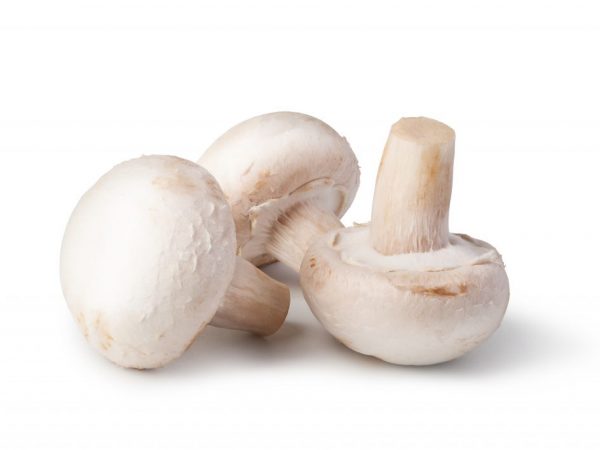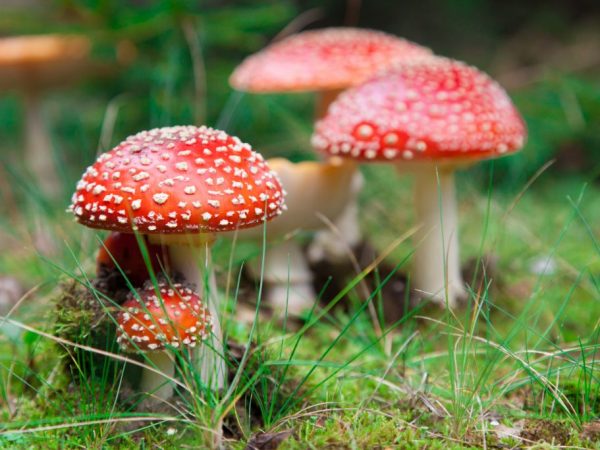What mushrooms are collected in the Moscow region in July
Mushrooms differ in taste and appearance time. Mushrooms of the Moscow Region amaze lovers of "quiet hunting" with their diversity in July. Before collecting, you need to prepare, find out which of them are useful and which are poisonous, which are dried, and which are suitable for frying or cooking. In general, decide for what and where you are going to go.

What mushrooms are collected in the Moscow region in July
general characteristics
Before collecting, you should decide for what purposes the mushrooms will be used. They are divided into 2 broad groups: poisonous and edible. Edible and conditionally edible have 4 categories in terms of their value:
- Category 1: white, milk mushrooms, pyzhik and spruce - the most delicious and aromatic.
- Category 2: volnushki (white and pink), oak, butterdish, boletus, boletus, Polish mushroom, champignons are slightly worse than the first ones in taste.
- Category 3: Valui, chanterelle, butter dish, flywheel, honey agaric, boletus (black and marsh), russula morels have a taste of average quality.
- Category 4: milk mushrooms, oyster mushrooms, honey agarics, cobwebs, mushrooms (forest, pink-lamellar), dung beetles, marsh boletus.
Most of the species from the 4th group are conditionally edible; special skills and knowledge are required to cook them for food. Their heat treatment should last at least 40 minutes. This is necessary due to the presence of highly irritating compounds in the fruiting bodies. You can remove them by boiling or prolonged (at least 3 days) soaking the mushrooms in cold water with regular changes. Only after that, category 4 mushrooms can be eaten. You cannot neglect the rules developed by our ancestors, because they collected their knowledge bit by bit and passed it on to us - to their descendants.
Interestingly, a number of mushrooms, which are considered traditional delicacies in Russia, are included in the list of inedibles in European countries.
Types of July mushrooms in the Moscow region
July is rich in mushroom harvest. They appear immediately after the rains.
Edible july mushrooms
A good harvest is harvested after a warm summer rain, when the moisture in the soil rises and the temperature fluctuates between 15 ° C and 17 ° C.
In the Moscow region in July, the following varieties grow:
- milk mushrooms;
- pechin (champignons);
- loading;
- chanterelles;
- White mushrooms;
- pigs;
- boletus;
- chanterelles;
- oyster mushrooms;
- Polish mushroom.
Most species grow in coniferous or mixed forests.
Russula and chanterelles appear first. Polish - from the second decade of July to late autumn, they grow at the foot of trees or pines.
Umbrella mushrooms appear after July 14 in sunny meadows or forest edges. Porcini mushrooms and their varieties, as well as boletus mushrooms and aspen mushrooms, are easy to find in birch groves or mixed forests.
Inedible mushrooms in the Moscow region

Amanita muscaria
Poisonous mushrooms are often disguised as edible ones. One toadstool can ruin a whole barrel of pickles.
The following inedible mushrooms grow in the Moscow region:
- bilious, hare (cleft lip) mushroom;
- the pig is thin;
- toadstool is pale;
- fly agaric.
Hare mushroom: its second name is bilious, because it tastes bitter like bile. Outwardly, the mushroom looks like a white one, but upon close examination, a black mesh on the leg and pink pores on the back of the cap are visible, i.e. the surface of the hymenophore (spore-bearing layer). It is often called the "false white mushroom".
The pig is thin: it is often confused with the edible pig. The slender pig appears in early July. Thin pig since 1993 on the territory of the Russian Federation is officially included in the list of inedible and poisonous mushrooms. It was found that her fruiting body contains compounds that cause the destruction of red blood cells, which in turn provokes a decrease in the level of hemoglobin, and therefore the oxygen required for breathing in the blood.
Irina Selyutina (Biologist):
The slender pig until 1984 on the territory of the USSR belonged to the group of conditionally edible mushrooms. But it was excluded from it and classified as poisonous. As it turned out, when it is eaten in the human body, there is an accumulation of a special compound - an antigen, which accumulates in the blood, settling on the surface of erythrocytes. After the death of its carrier, this compound is transferred to a new blood cell. As a result, a response occurs in the body and conditions that lead to death develop.
Toadstool is pale: dangerous poisonous mushroom. The russula is confused with it. In order not to be mistaken, they carefully examine the leg: a "skirt" is visible on the toadstool. In addition, the base of the toadstool's leg has a pronounced expansion very much resembling in appearance a potato tuber and immersed in a "bag" - the remains of a common blanket. This is not the case with edible mushrooms. Therefore, as soon as you saw that the leg below is expanded and enveloped in a cover, go away, do not touch the mushroom. In addition, it was found that nothing should be picked within a radius of up to 3 m around the mushroom of the pale toadstool. It turns out, firstly, everything is covered (seeded) with the spores of this fungus, and secondly, the mycelium of the toadstool, in contact with the hyphae of the edible mushroom growing nearby, “shares” its toxins with it.
Irina Selyutina (Biologist):
Attention! In case of poisoning with a pale toadstool, in no case should you use alcoholic beverages to "disinfect" the internal organs. Alcohol not only will not destroy toxins, but vice versa, will help them penetrate the bloodstream even faster and spread throughout the body, which can accelerate irreversible processes.
Amanita muscaria: deadly mushrooms, in which the alkaloid muscarine was found. In addition to it, ibotenic acid and its metabolite (a compound formed in the process of chemical transformations of this compound) muscimol were found there. Muscarine, entering the body, causes serious poisoning with typical manifestations of intoxication of the body. The lethal dose for an adult is 15 eaten caps of red fly agaric, but since it has a very "bright" appearance and it is extremely difficult to confuse a mushroom with edible species, the likelihood of fatal poisoning if it is accidentally eaten together with other mushrooms is very, very small , or rather - unlikely.
Did you know? The peoples of the Far North have known the red fly agaric for at least 3500 years and has special names, among the Chukchi - Vanak, among the Evenks - okay.
Very often mushroom pickers are guided in edible-poisonous mushrooms by the characteristic sponginess of the cap of edible species, while in poisonous ones there is a lamellar cap. However, it should not be forgotten that among the lamellar mushrooms there are many excellent edible species. It's just that the mushroom picker needs to be careful not to send a poisonous or inedible specimen into his box, which has become an overgrown edible mushroom.
Benefit and harm
The composition of mushrooms contains a huge amount of vitamins (A, C, E, D, group B, etc.), micro- and macroelements and minerals (potassium, calcium, iron, magnesium, manganese, etc.), fiber, i.e. the mass of connections necessary for a person. In addition, they may also contain toxic substances that can cause not only food poisoning or cause hallucinations, but also kill.
Benefit
The content of useful trace elements in the pulp of mushrooms has been proven by science. By the amount of protein, mushrooms are superior to meat, which made it possible to call them "forest meat".
They are 90% water and have a low calorie content. In their composition, the presence of 18 amino acids necessary for cell construction, potassium, calcium, manganese and phosphorus, was determined. They contain vitamins A, B, D, E and niacin.
The use of mushrooms contributes to anticancer therapy, has antitumor and immunostimulating effects. This is the merit of the beta-glucan included in the composition.
Harm
Mushrooms, although low in calories, should not be eaten constantly and haphazardly. They are hard to digest. When they enter the stomach, the digestion process slows down. It is difficult for the body to process chitin. Its largest content (in percentage) falls on the legs.
Mushrooms have the ability to absorb toxins from the environment, which negatively affects the nutritional quality of the product. If they are improperly processed before conservation, then without knowing this, it is possible to create favorable conditions for the development of the causative agent of botulism in the banks.
Contraindications
Despite the presence of a lot of useful qualities, there are contraindications for the use of mushrooms:
- cannot be eaten by people with individual intolerance to the product (allergic reaction);
- in the presence of a peptic ulcer or problems of the gastrointestinal tract;
- children's age (for different species it varies within different limits, it is better to abstain until 12-14 years old). This is due to the physiological immaturity of the digestive system, as a result of which the necessary enzymes are not yet released;
- during pregnancy, mushrooms can cause bloating, nausea, or constipation;
- during lactation.
It is not recommended to eat mushrooms for gout, liver or kidney disease, even in remission.
If you have health problems, then before starting to eat mushrooms, it is better to consult with your doctor and rely on his recommendations in the future.
Conclusion
To get pleasure from hiking in the forest and collect only tasty and healthy mushrooms, you should follow all precautions while collecting mushrooms, separate poisonous from useful ones. And the main thing is to properly process them at home.



